Paesi nouamente retrouati. Et Nouo Mondo da Alberico Velputio Florentino intitulato (1507):
Findings from a Study of the Oldest Book in the Oliveira Lima Library
Erin Mir-Aliyev
Master of Science in Library and Information Science – The Catholic University of America
Flora de Oliveira Lima Fellowship for Graduate Students in Library and Information Science – The Oliveira Lima Library

As part of a rare books course this past fall, I was given an assignment to choose any book I wanted and to “write its biography”. Since I wanted to be able to review and make use of everything I had been learning about how to conduct bibliography in my classes, as well as take advantage of all of the rare books available to me in the Oliveira Lima Library collection, I decided to take a closer look at the oldest book contained in it – a work titled Paesi nouamente retrouati. Et Nouo Mondo da Alberico Velputio Florentino intitulato (Images 2 and 3). Compiled by Fracanzano da Montalboddo and first published in 1507, it contains the first printed narrative of the voyage of discovery of Brazil by Pedro Alvares Cabral among other early accounts of early exploratory voyages by Europeans, and is a very significant resource for many patrons of the collection.
Resources Consulted

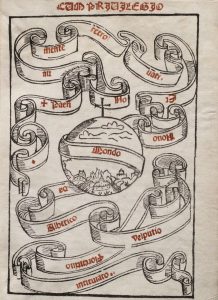
My main task was to examine the physical characteristics of the copy available to me, the digitized version of the 1507 edition copy held by Oliveira Lima Library and available to the CUA community through Gale’s Brazilian and Portuguese History and Culture collection, in order to understand the processes involved in how it was made. I also compared this copy to another edition, which in this case was a digitized copy of a 1508 edition published as a facsimile in 1916 and held at Harvard University’s collection. Besides these two copies of the book, I also found useful information from outside sources including Ruth E. V. Holmes’ 1926 bibliography Bibliographical and historical description of the rarest books in the Oliveira Lima collection at the Catholic university of America, lists of known editions such as the one on the John Carter Brown Library website, Philip Gaskell’s book A New Introduction to Bibliography, and a 1917 article about Vespucci reprints in The American Historical Review. Going through this process allowed me to better understand where to go for bibliographical information and what to look for when studying books as artifacts, in order to gather clues about a book’s origin and the history of its development. This exercise also highlighted the continued importance of being able to physically, not only digitally, access books in library collections, as the information I was able to glean was limited by only viewing digitized versions. In order to give an idea of what kinds of information bibliographical research can uncover, as well as some limitations encountered, I briefly describe a few interesting things I discovered by analyzing the information I found through secondary sources as well as from looking at the physical traits of the copies themselves.
Circumstances of Compilation and Production
While common knowledge of the culture and time period in which Paesi was written, such as the atmosphere of competition between European nations to find and claim new lands, was helpful, researching also led me to detailed information about circumstances surrounding the book’s creation. Holmes’ bibliography contributed to my understanding of this a lot. According to her, writings by Jose Carlos Rodrigues reveal that a Venetian admiral and historian named Malipiero had connections to Venetian ambassadors in Madrid and Lisbon, who covertly passed on news and details of the voyage and discovery of Brazil mentioned within the text. One of these ambassadors had access to a letter from Pero Vaz de Caminha to King Dom Manoel of Portugal concerning the voyages, and based on the knowledge contained therein wrote a letter to Malipiero. It arrived too late for Malipiero to use it in the composition of his own works. However, Fracanzano da Montalboddo, a well-known sixteenth-century professor at Vicentia, Italy, was still able to use it to compile Paesi. This bit of information reveals that detailed knowledge about these exploratory voyages was not necessarily meant to be shared between different countries or meant for the average person, and hints that this knowledge about the Portuguese journeys contained in the text was probably not meant to be published, at least not at that time or in Italy. However, certain groups of people were seeking after it and produced the text anyway.
Quality of Materials and Unfinished Pages
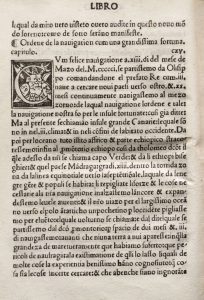
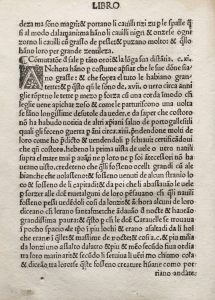
Examination of the digitized images of the paper used in the production of the 1507 edition copy appears to indicate that quality was less of a concern as printing progressed. Some pages appear to be higher quality; these are mostly in the first half of the book and appear whiter in color, flatter, and without major flaws. Other pages, mostly in the second half of the book, have a more off-white color and have many imperfections such as warping that appear to have originated in the paper-making process (Images 4 & 5). Paper quality especially seems lower towards the end of the book, in section six. This variation in paper quality throughout the book could indicate that the creator or printer was running out of money towards the end of the printing of this book, and began to use any paper he could afford. It could also indicate that time became more of a concern, and that less focus was placed on having the best materials and more focus was placed on finishing the book the later into the process he got. Paper quality does not appear to be so varied in the 1508 edition copy, though the ability to see the paper closely in this version was more difficult due to the way the facsimile was made.
As mentioned before, this activity highlighted the necessity of accessing a physical copy of a book to thoroughly research some aspects of it or confirm certain details, which was at the time impossible due to Covid restrictions. A patron’s ability to analyze certain aspects of a book like paper, chain lines, format, ink, bindings, etc. are very limited without being able to hold and handle the object in person. This activity also brought to attention how often the bindings, covers, endpapers, and flyleaves of books are often not even digitized with other content deemed significant by whoever is doing the digitizing, leading to important information contained in those features being lost to those who only have access to digital versions. Good quality digitization, with the goal of providing patrons with as close a representation of the original object as possible, should include these features in the digitization process.
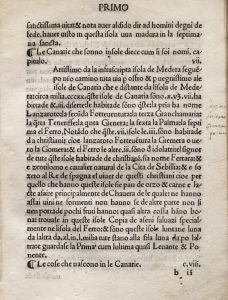
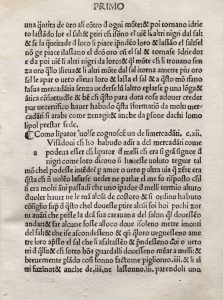
Similarly, something else interesting about the 1507 edition copy is that there are several pages in the second half of the book, especially in sections five and six, where the empty space intended to contain a block print of a large, decorative beginning letter is not filled with any design (Images 6 & 7).
Since this is something that would have been completed by hand after printing with the press, it is as if the printer was inattentive or rushed at this point in the process. When taken into consideration along with the decreasing paper quality mentioned above, it could indicate an instance of rushed production in which these details were not carefully checked before distribution of the final product. It could also indicate the importance of the written content over artistic details. It is unknown whether this is something unique to this individual copy, or something encountered in all 1507 edition copies. In contrast, the 1508 edition copy I looked at does not appear to be missing any of these images.
Different Perspectives Over Time
Reviewing the editions of this work that have been produced since the first one in 1507, also led me to realize how Paesi has remained relevant and important for scholars since the sixteenth century, but the format in which it is presented has changed. Unlike the 1507 edition and other early editions in which Paesi was published as its own standalone book, the 1916 version of the 1508 edition was created as part of a series of similar books, all containing Vespucci texts. The context of creation for this 1916 version is different in that the text is embedded within a body of similar information not originally associated with it, and the point of view of the creator and reader of this one is very different from the one that a creator or reader in 1507 would have had. The knowledge we now have of the events and results of the age of exploration contributes to how the information about it is now presented, consumed, and understood.
All of the conclusions made in this study are of course preliminary, but this was still a valuable exercise that taught me to start thinking as bibliographers do about the materials I encounter each day.
